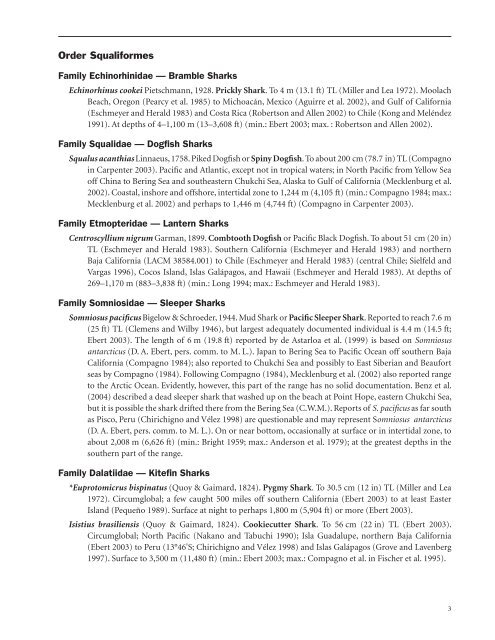Untitled - Alaska Resources Library
Untitled - Alaska Resources Library
Untitled - Alaska Resources Library
Create successful ePaper yourself
Turn your PDF publications into a flip-book with our unique Google optimized e-Paper software.
Order Squaliformes<br />
Family Echinorhinidae — Bramble Sharks<br />
Echinorhinus cookei Pietschmann, 1928. Prickly Shark. To 4 m (13.1 ft) TL (Miller and Lea 1972). Moolach<br />
Beach, Oregon (Pearcy et al. 1985) to Michoacán, Mexico (Aguirre et al. 2002), and Gulf of California<br />
(Eschmeyer and Herald 1983) and Costa Rica (Robertson and Allen 2002) to Chile (Kong and Meléndez<br />
1991). At depths of 4–1,100 m (13–3,608 ft) (min.: Ebert 2003; max. : Robertson and Allen 2002).<br />
Family Squalidae — Dogfish Sharks<br />
Squalus acanthias Linnaeus, 1758. Piked Dogfish or Spiny Dogfish. To about 200 cm (78.7 in) TL (Compagno<br />
in Carpenter 2003). Pacific and Atlantic, except not in tropical waters; in North Pacific from Yellow Sea<br />
off China to Bering Sea and southeastern Chukchi Sea, <strong>Alaska</strong> to Gulf of California (Mecklenburg et al.<br />
2002). Coastal, inshore and offshore, intertidal zone to 1,244 m (4,105 ft) (min.: Compagno 1984; max.:<br />
Mecklenburg et al. 2002) and perhaps to 1,446 m (4,744 ft) (Compagno in Carpenter 2003).<br />
Family Etmopteridae — Lantern Sharks<br />
Centroscyllium nigrum Garman, 1899. Combtooth Dogfish or Pacific Black Dogfish. To about 51 cm (20 in)<br />
TL (Eschmeyer and Herald 1983). Southern California (Eschmeyer and Herald 1983) and northern<br />
Baja California (LACM 38584.001) to Chile (Eschmeyer and Herald 1983) (central Chile; Sielfeld and<br />
Vargas 1996), Cocos Island, Islas Galápagos, and Hawaii (Eschmeyer and Herald 1983). At depths of<br />
269–1,170 m (883–3,838 ft) (min.: Long 1994; max.: Eschmeyer and Herald 1983).<br />
Family Somniosidae — Sleeper Sharks<br />
Somniosus pacificus Bigelow & Schroeder, 1944. Mud Shark or Pacific Sleeper Shark. Reported to reach 7.6 m<br />
(25 ft) TL (Clemens and Wilby 1946), but largest adequately documented individual is 4.4 m (14.5 ft;<br />
Ebert 2003). The length of 6 m (19.8 ft) reported by de Astarloa et al. (1999) is based on Somniosus<br />
antarcticus (D. A. Ebert, pers. comm. to M. L.). Japan to Bering Sea to Pacific Ocean off southern Baja<br />
California (Compagno 1984); also reported to Chukchi Sea and possibly to East Siberian and Beaufort<br />
seas by Compagno (1984). Following Compagno (1984), Mecklenburg et al. (2002) also reported range<br />
to the Arctic Ocean. Evidently, however, this part of the range has no solid documentation. Benz et al.<br />
(2004) described a dead sleeper shark that washed up on the beach at Point Hope, eastern Chukchi Sea,<br />
but it is possible the shark drifted there from the Bering Sea (C.W.M.). Reports of S. pacificus as far south<br />
as Pisco, Peru (Chirichigno and Vélez 1998) are questionable and may represent Somniosus antarcticus<br />
(D. A. Ebert, pers. comm. to M. L.). On or near bottom, occasionally at surface or in intertidal zone, to<br />
about 2,008 m (6,626 ft) (min.: Bright 1959; max.: Anderson et al. 1979); at the greatest depths in the<br />
southern part of the range.<br />
Family Dalatiidae — Kitefin Sharks<br />
*Euprotomicrus bispinatus (Quoy & Gaimard, 1824). Pygmy Shark. To 30.5 cm (12 in) TL (Miller and Lea<br />
1972). Circumglobal; a few caught 500 miles off southern California (Ebert 2003) to at least Easter<br />
Island (Pequeño 1989). Surface at night to perhaps 1,800 m (5,904 ft) or more (Ebert 2003).<br />
Isistius brasiliensis (Quoy & Gaimard, 1824). Cookiecutter Shark. To 56 cm (22 in) TL (Ebert 2003).<br />
Circumglobal; North Pacific (Nakano and Tabuchi 1990); Isla Guadalupe, northern Baja California<br />
(Ebert 2003) to Peru (13°46'S; Chirichigno and Vélez 1998) and Islas Galápagos (Grove and Lavenberg<br />
1997). Surface to 3,500 m (11,480 ft) (min.: Ebert 2003; max.: Compagno et al. in Fischer et al. 1995).<br />
3
















